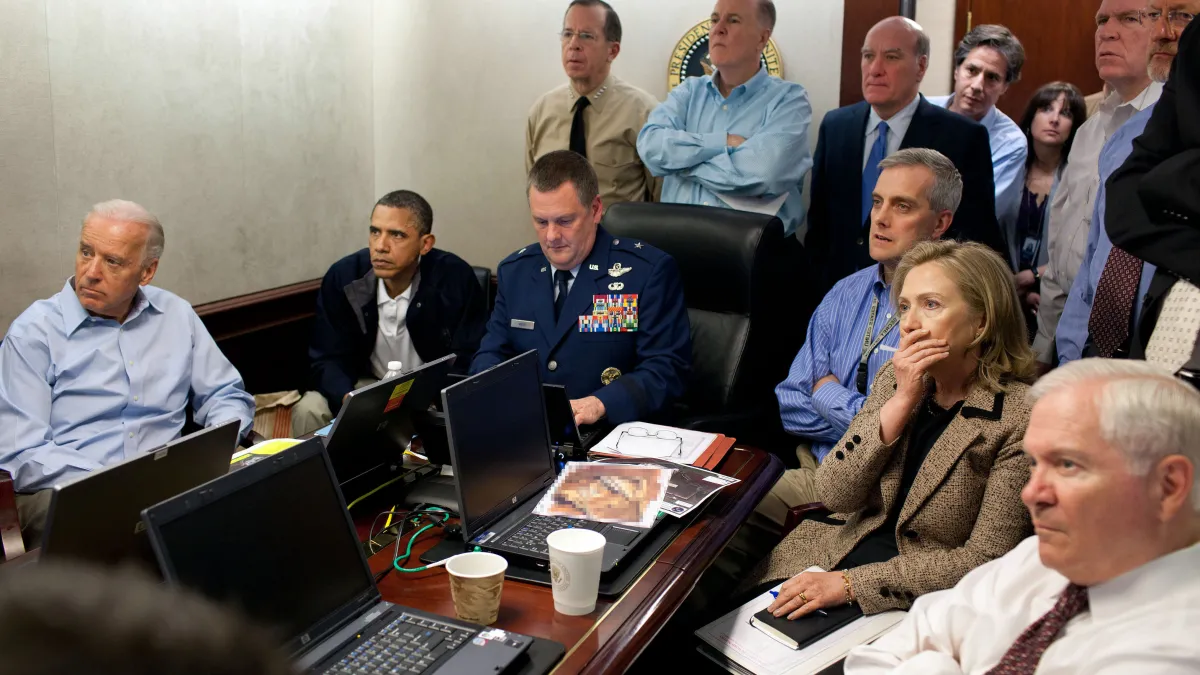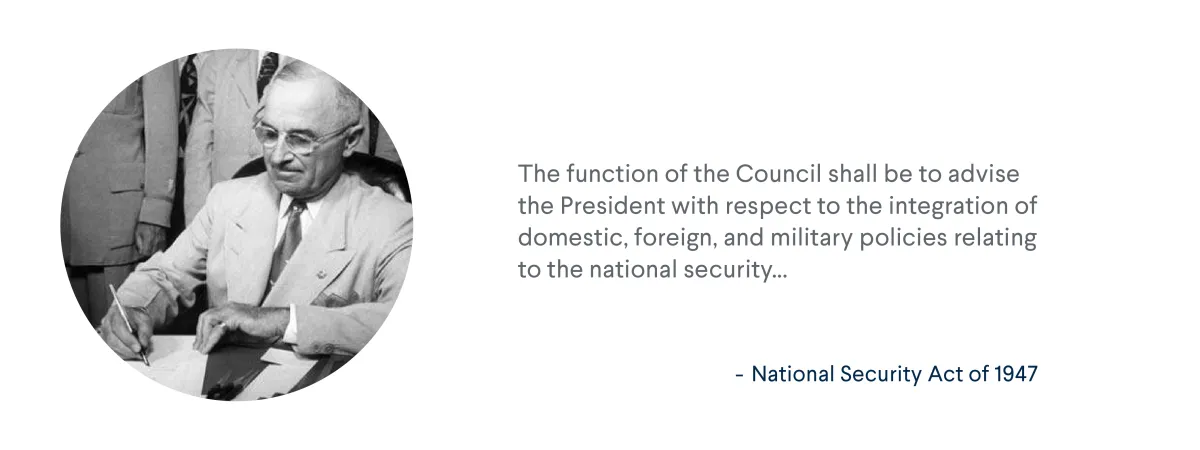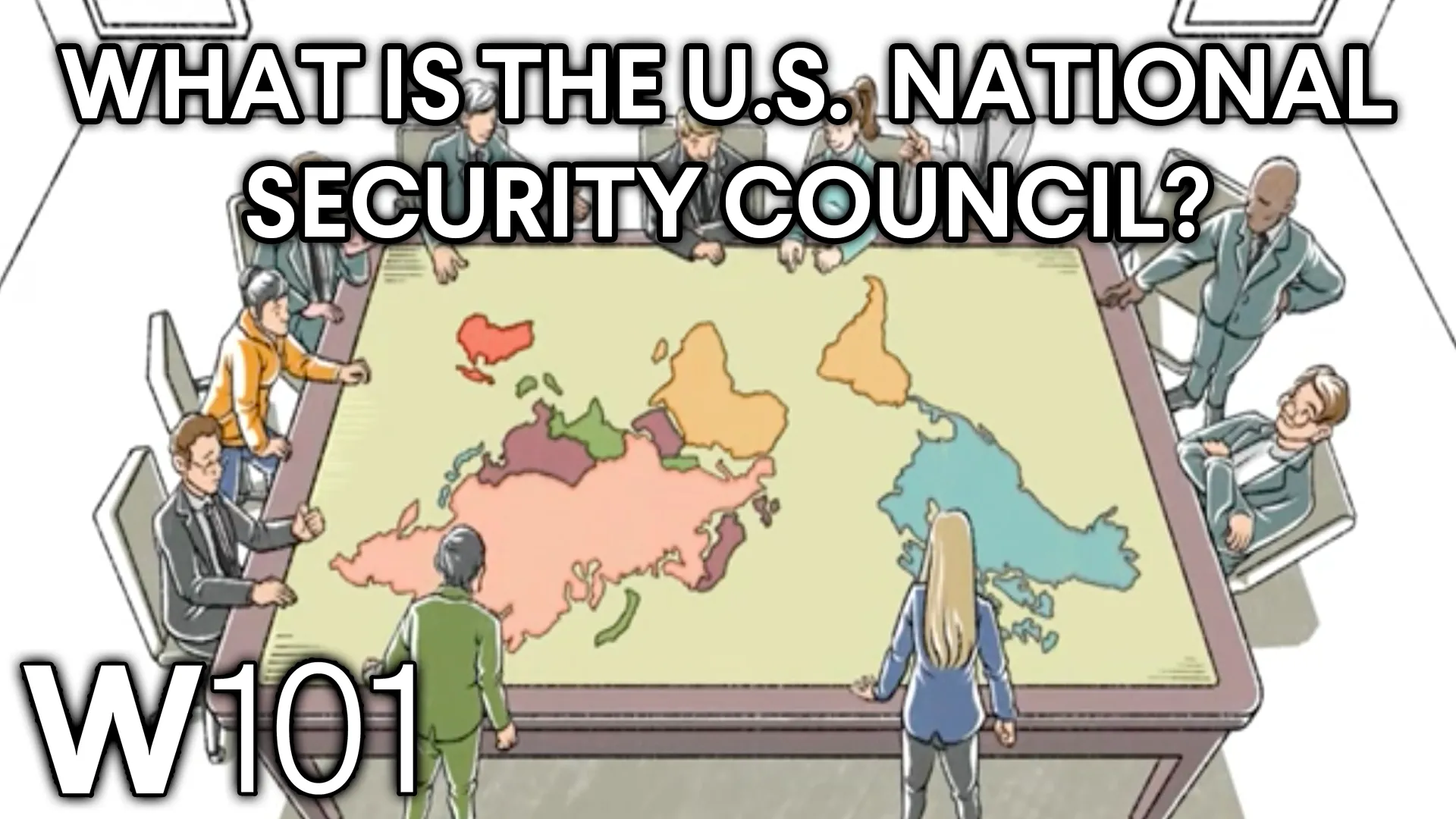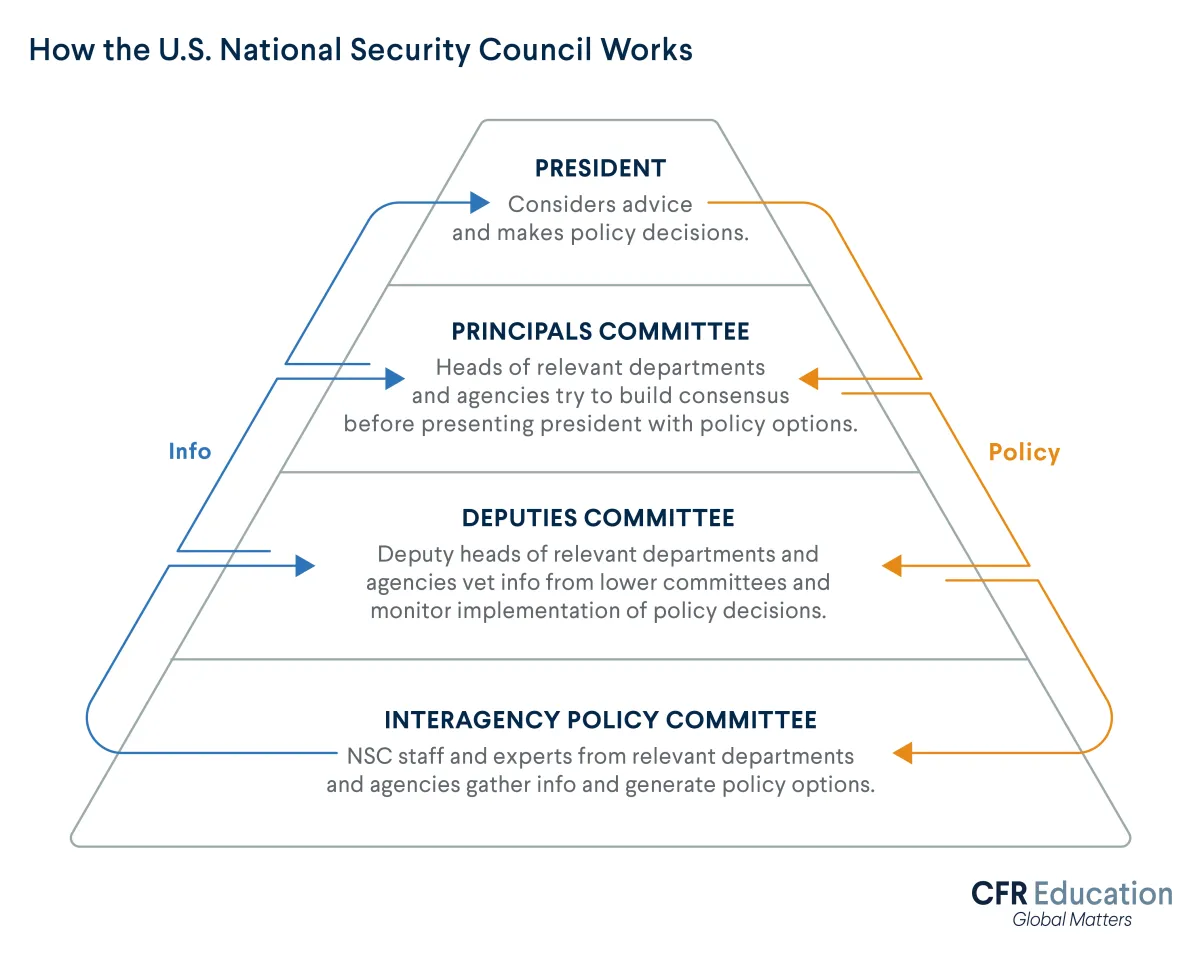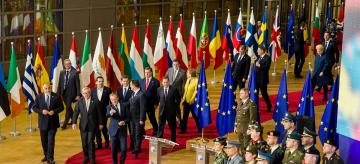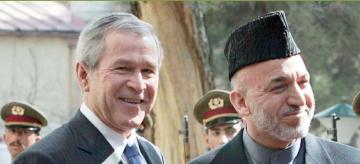What Is the National Security Council?
Learn how the president’s advisors protect U.S. national security and help with foreign policy decision-making and coordination across the executive branch.
On April 28, 2011, President Barack Obama reviewed intelligence indicating that al-Qaeda leader Osama bin Laden could be hiding in a compound in Pakistan. He considered how to respond: he could tap the military to conduct a raid, authorize a drone strike on the location, or choose to hold off entirely given the uncertainty of the intelligence.
To help him decide, the president assembled the National Security Council (NSC). The NSC is a group of top advisors tasked with providing guidance on foreign policy matters and implementing the president’s decisions.
In that April meeting, NSC members talked through the president’s options. The advisors in the room were not unanimous, but most favored a raid. Obama considered the information and ultimately greenlit a special forces mission that would kill bin Laden.
In this resource, we’ll explore what the NSC is, how it came to be, and how it helps the president make U.S. foreign policy choices.
History of the National Security Council
Before World War II, the United States’ military and foreign policy–making machinery was disjointed. The State Department, War Department, and the U.S. Navy largely all acted separately. Any coordination across departments was an informal process.
Each department had internal priorities and biases in how it wanted to conduct policy, which led to disagreement. As a result, the United States military and foreign policy–making apparatuses were marred with unhealthy competition and inefficiency. These conditions were a major problem as World War II unfolded. President Harry S Truman, for instance, believed the United States could have foreseen the 1941 aerial bombardment on Pearl Harbor had those various departments collaborated effectively.
As World War II concluded and the Cold War with the Soviet Union heated up, the United States set out to integrate its military and diplomatic policymaking processes. To that end, Congress passed the National Security Act in 1947. This law combined the country’s independent military agencies into a unified Department of Defense and created the CIA. The National Security Act also established the National Security Council.
What does the National Security Council do?
Nested inside the executive branch, the NSC offers a forum for members of the departments and agencies involved in protecting U.S. national security—such as the Departments of State, Defense, and Treasury—to convene and recommend policy options to the president. The NSC folds foreign and military policymaking into an interagency process. This structure allows the president to incorporate various departments’ perspectives into decision-making. The interagency process ensures government departments coordinate to share information and implement policies.
Crucially, the NSC is primarily an advisory body. The president can delegate some decisions on matters to the council when members find consensus. However, final decisions on the most important national security issues rest with the occupant of the Oval Office.
Who are the National Security Council members?
The National Security Act names several members of the government as required, or statutory, members of the NSC.
The NSC’s statutory members include
- the president, the head of state and the commander in chief of the U.S. Armed Forces;
- the vice president, the second highest-ranking official of the U.S. government and often a close advisor to the president;
- the secretary of state, the president’s chief advisor on foreign affairs;
- the secretary of defense, the president’s principal advisor on defense policy;
- the secretary of the treasury, one of the president’s chief economic advisors;
- the secretary of energy, one of the president’s top advisors on energy, environmental, and nuclear issues;
- the chairman of the joint chiefs of staff, the highest-ranking member of the U.S. Armed Forces and the top military advisor to the president; and
- the director of national intelligence, the president’s leading advisor on matters relating to intelligence.
In practice, however, the NSC’s membership is larger. The NSC comprises both statutory members and officials whom the president designates as members.
That means the NSC typically also includes
- the national security advisor, the president’s senior advisor on national security issues;
- the chief of staff to the president, a close advisor to the president responsible for guiding the process of communicating and implementing presidential decisions;
- the U.S. representative to the United Nations, a U.S. ambassador responsible for advancing U.S. foreign policy interests at the United Nations;
- the attorney general, the head of the Department of Justice and chief lawyer to the U.S. government; and
- the secretary of homeland security, one of the president’s top advisors on threats to U.S. security like terrorism, natural disasters, and cyberattacks.
Official NSC meetings require the full council’s presence. However, presidents will often convene informal meetings limited only to NSC members with expertise relevant to the issue being discussed.
One of the council’s most crucial members is the national security advisor (NSA). The NSA is often one of the president’s closest personal advisors. As they do not represent a specific government department, they are meant to moderate discussions and serve as honest brokers between NSC members representing departments with conflicting interests. The NSA also oversees NSC staff and coordinates with other NSC members to ensure agencies are carrying out presidential decisions.
Watch this video to take a closer look at what some of these NSC members do:
To support its work, the NSC also maintains a staff comprising individuals hired by the White House and members of the NSC’s component departments. The NSC staff varies in size and structure with each new administration. That said, NSC staff have included as many as four hundred members in the past. Under President Joe Biden, NSC staff number roughly 350 members.
The NSC staff supports the council by providing expertise on the numerous issues of national security and foreign policy that the NSC and president need to consider. Other staff responsibilities include preparing speeches and memos for the president or other NSC members. The NSC staff is also responsible for handling congressional inquiries related to foreign policy.
How does the National Security Council work?
The National Security Act did not specify how the NSC should operate. That has allowed the NSC to evolve significantly according to the president and international challenges.
Over the decades, presidents have taken various approaches to how frequently meetings are held, who attends them, how decisions get made, and how large the NSC’s supporting staff should be. Those factors can change significantly, even throughout a single president’s administration. Truman, for instance, initially avoided and distrusted the body, viewing it as an inconvenience imposed by Congress. The outbreak of the Korean War, however, changed his mind. Successful military operations in Korea were staked on the interagency coordination that only the NSC could provide. Truman eventually came to rely heavily on the council. He attended all but seven of seventy-one meetings held during the war.
Subsequent presidents have continued to vary the way they structure and use the NSC. Yet over the years, a core framework has solidified that remains in place today. This framework relies on layers of committees that support the NSC and ensure a streamlined flow of information to the president.
Let’s look at this structure by following one path an issue can take as it makes its way to the president.
Interagency Policy Committees (IPCs)
The foreign–policymaking process usually begins in an Interagency Policy Committee, made up of experts from various departments. IPCs study issues, combining information and perspectives from members’ respective departments. IPCs then formulate possible courses of action to respond to those issues. Dozens of IPCs can run concurrently, focused on geographic regions or issues such as terrorism, arms control, or global health crises.
The Deputies Committee (DC)
Next, the issue moves up to the Deputies Committee. This committee is comprised of the deputy leaders of the departments represented on the NSC. Typically, most of the consensus-building on policy options occurs here as officials debate IPC findings. The DC also refines policy options and recommendations to send up the chain.
The DC directs the formation of IPCs below it and monitors how departments implement policy.
The Principals Committee (PC)
Next, the issue rises to the attention of the Principals Committee, which typically includes all members of the NSC except the president and vice president. The PC works to ensure policy options brought for final consideration before the president already reflect as much consensus and coordination as possible.
Members of the PC also direct their departments on how to execute the president’s policy decisions.
The National Security Council (NSC)
Finally, NSC members convene to present their recommendations to the president.
Formal NSC meetings are chaired by the president and occur whenever the president sees fit. They consider issues that the NSC or president decide require the president’s personal attention or that need direct presidential approval to act upon. These actions include military strikes, sanctions, or covert actions.
The committee structure is meant to ensure that when it comes time for presidents to make foreign policy decisions, they will be presented only with the best options available, supported by the best information available. However, decision-making doesn’t always flow through this process. Often, if the Deputies or Principals Committees can reach a consensus on the right thing to do, they will make a final decision. The NSC reserves the president’s time for the most important or thorniest issues. In other cases, presidents only involve the PC or NSC in policy deliberations to keep discussions secret or speed them along. For example, following the terrorist attacks of September 11, 2001, the extreme urgency of the crisis drove President George W. Bush to immediately convene the full NSC.
The NSC: a vital policymaking tool for presidents
Crafting effective foreign policy is difficult in the best of times. The NSC plays a vital role in U.S. foreign policy-making. The forum ensures the president can lean on the full expertise and capabilities of the executive branch to make the best decision possible. When high-stakes situations arise— like the discovery of bin Laden’s hideout, the NSC proves an invaluable tool for coordinating and executing policy.
To experience what it’s like to run an NSC meeting and make difficult foreign policy decisions, check out Convene the Council.
